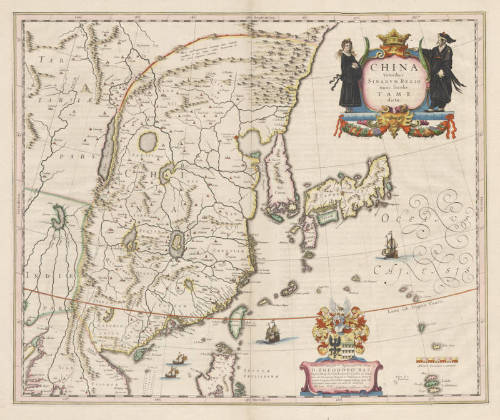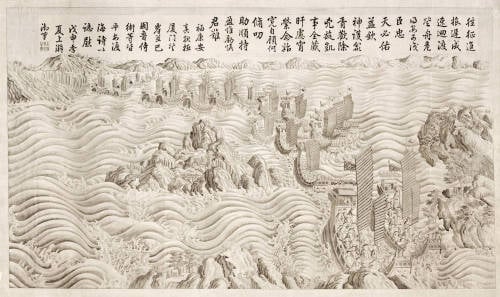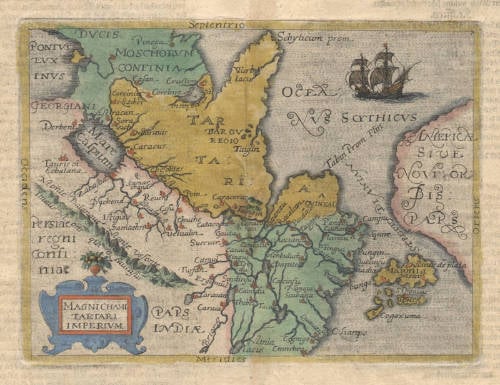Leen Helmink Antique Maps
Antique map of Beijing province by Blaeu/Martini
The item below has been sold, but if you enter your email address we will notify you in case we have another example that is not yet listed or as soon as we receive another example.
Stock number: 18893
Zoom ImageCartographer(s)
Joan Blaeu (biography)
Title
Pecheli, sive PEKING, Imperii Sinarum Provincia Prima.
First Published
Amsterdam, 1655
This Edition
1664 Atlas Maior
Size
39.5 x 48 cms
Technique
Condition
mint
Price
This Item is Sold
Description
Joan Blaeu's beautiful map of the province of Hebei or Pei Chih-li, Beijing or Peking, engraved after a manuscript map by the Jesuit Martino Martini who traveled in China for seven years, and who visited Blaeu in Amsterdam in 1654 during a travel through Europe.
The map here is the best and most sought-after 17th century map of the province of Peking. Along the top is the Great Wall, that keeps the barbarians out. In the upper right is a beautiful cartouche with a cartographer and a cosmographer, showing two scalebars: one in Chinese Miles (Li), and one in Dutch Nautical Miles of 15 in a degree.
The map is famous for its extremely decorative title cartouche, showing the Chinese imperial family, two servants, and two beautiful birds, perhaps birds of paradise or an exotic species of parrots.
Condition
From the 1664 edition of Joan Blaeu's Atlas Maior. Thick paper with wide margins. Attractive original hand color, applied by the Blaeu publishing house at the time of production. An excellent collector's example of this seminal map.
BLAEU's - The Grand Atlas of the 17th Century
Hebei, the First Province of China, includes Beijing, and is suitably the most decorative of the series of regional maps in the Martini series.
The title is enclosed within a charming set-piece composed of two Chinese elders seated in ornamental chairs, with their servants and a pair of extremely flamboyant birds, their form delightfully emphasized by the rich coloring.
It is not known why Beijing, (thus named since the fifteenth century, after a short period as Kublai Khan's Cambaluc), should here be called Xuntien.
Note the detailed key to the categories of towns given by Martini to the left of the title ornament.
(John Goss).
THE [BLAEU] ATLAS OF CHINA
The publication of the atlas of China seems to owe more to coincidence than to planning. In 1654, in the foreword to the Dutch edition of the atlas of Scotland, Joan Blaeu announced that he was preparing town books of Italy, a volume of charts, and a volume of historical maps, and that these were delayed. But while he was working on these volumes, wrote Blaeu, Father Martinus Martini had come from the Indies, bringing with him his sketches and descriptions of the Chinese empire. Martini persisted in his attempt to have Blaeu engrave and publish these, so Blaeu postponed the work on the other volumes to prepare the atlas of China, and published it about a year later.
Martinus Martini (1614-1661) began working in 1642 as a Jesuit missionary in various provinces of China. When he was ordered to Rome in 1651, he took with him more than 50 Chinese books and maps, among them a copy of the manuscript atlas of the Chinese provinces by Zhu Siben, compiled in 1311/12, with revisions from the printed atlas by Lo Hongxian (1555).
Martini's ship was captured by the Dutch and brought to Java. Martini was sent to Amsterdam where he arrived in 1654. During the voyage to Europe aboard the Dutch East-Indiamen, Martini made a Latin translation of the text and wrote his own description of China. In 1659, Joan Blaeu published the Latin translation, titled "Sinicae historiae decas prima", separately without maps. The text in Blaeu's atlas of China is Martini's own account, written in the first person, of the geography and history, the manners and customs of the Chinese empire and its peoples.
Martini's atlas of China includes the following parts:
1. A lengthy preface by Martinus Martini with an explanation of how he compiled his maps from the Chinese originals.
2. A general map of China (map 1).
3. A geographical description of the 15 provinces of China, each description preceded by a map of that province (maps 2-16).
4. A geographical description of Japan with a map (map 17).
5. The “Catalogus Longitudinum ac Latitudinem,” a list of towns with their geographical co-ordinates.
6. A supplement to the geographical description by Jacob Golius, “De Regno Catayo Additamentum Iacobus Golius Lectori.”
7. A history of the Manshu War by Martinus Martini, “De Bello Tartarico Historia " originally published in 1654 in Antwerp, with an additional letter by Francisco Brancaro from Shanghai, 14 November 1651.
The atlas of China was published by Joan Blaeu in five different languages: Latin, French, Dutch, German, and Spanish. It was published separately and added as the sixth volume to the Theatrum Orbis Terrarum, the only difference being in the engraved title page. Title page 2:26A, which was used for the Theatrum edition, has a blank panel for the letterpress volume title. The second title page, 2:26B, was used for the separate editions of the atlas. Both title pages have the title of the atlas and the name of the author in Latin, but, strangely enough, the name of the publisher does not appear on the title page or anywhere else in the volume. In several libraries, therefore, the atlas of China is not recognized as a Blaeu atlas.
The volume was later bound up with the other maps and text of Asia to form the Asia volume of the Atlas Maior.
(Peter van der Krogt [8421:21])
Pieter Jansz
For the design of cartouches and decorations, 17th century publishers often copied from existing graphic art, or were inspired by it. But in special cases like here, dedicated assignments were given to artists for the creation of new designs. This was the case with Joan Blaeu’s Atlas of China.
Interestingly, the cartouche design can be ascribed with certainty to Pieter Jansz. (1602-1672), who is described in his lifetime as a ‘konstig glasschrijver’, an artist designer for stained glass windows. Pieter Jansz. was a pupil of Jan Philipsz. van Bouckhorst (1588-1632). Pieter married Oetje Jacobs in 1633 after which the couple lived in the Wolvestraat and Herengracht in Amsterdam (Schapelhouman 1985). Arnold Houbraken lists him as een konstig teekenaar op papier (a skillful draughtsman working on paper) in his important The Great Theatre of Dutch Painters (Houbraken 1721). The typical auricular style with so-called lobe-elements is present in his stained glass drawings as well as in his cartouche designs.
A collection of twelve stained windows by Jansz. is preserved in the Nederlandse Hervormde Kerk (Dutch Reformed Church) in Oudshoorn. The original drawings are preserved at the Rijksmuseum Amsterdam (Jansz. 1667). Pieter Jansz. drew many designs for stained glass church windows, but at least two dozen designs are known from his hand of map cartouches for Joan Blaeu. The Rijksmuseum Amsterdam keeps a collection of his cartouche drawings (Jansz. 1657-1662a-b). The design drawings were transfered onto the copperplate by indentation with a metal stylus and charcoal, resulting in a "carbon copy" on the plate to facilitate the copper engraving and/or etching process for the cartouches.
(Leen Helmink)
Willem Janszoon Blaeu (1571-1638)
Joan Blaeu (son) (1596-1673)
Cornelis Blaeu (son) (?-c.1642)
Willem Janszoon Blaeu died in October 1638, leaving his prospering business to his sons, Joan and Cornelis, who continued and expanded their father's ambitious plans.
After the premature death of his brother Cornelis in 1642, Joan directed the work alone and the whole atlas series of 6 volumes was eventually completed about 1655. As soon as it was finished he began the preparation of the even larger work, the Atlas Maior, which reached publication in 1662 in 11 volumes (later editions in 9-12 volumes) and contained nearly 600 double-page maps and 3,000 pages of text. This was, and indeed remains, the most magnificent work of its kind ever produced; perhaps its geographical content was not as up-to-date or as accurate as its author could have wished, but any deficiencies in that direction were more than compensated for by the fine engraving and colouring, the elaborate cartouches and pictorial and heraldic detail and especially the splendid calligraphy.
In 1672 a disastrous fire destroyed Blaeu's printing house in the Gravenstraat and a year afterwards Joan Blaeu died. The firm's surviving stocks of plates and maps were gradually dispersed, some of the plates being bought by F. de Wit and Schenk and Valck, before final closure in about 1695.
(Moreland and Bannister)
Related Categories
Related Items






